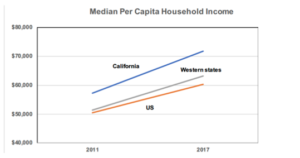By many important measures, California has never been better off. Our state enjoys unprecedented wealth, employment and health.
Our economy created 3.4 million jobs in the ten years since the worst of the Great Recession, a 24 percent growth spurt, driving the unemployment rate to a record low 3.9%. Our job growth has accounted for one out of every seven new US hires. This rising tide has lifted every county with increased employment and income, albeit with great variation.
Measured by per capita income, California is the fifth-wealthiest state in the country.
The nine-county Bay Area would itself be the nation’s richest state. Coastal Southern California would be the nation’s 7th richest state. On the other hand, the San Joaquin Valley and Inland Empire together would rank 48th among all states in wealth.
California continues to improve its health outcomes, ranking 12th among all states, compared with a ranking of 25th in 1994. Credit our low rates of smoking, obesity and occupational hazards, high physical activity, and enviable clinical care.
If you’re looking for a job or a healthy lifestyle, California remains a dream come true. But there’s a problem…
Many Californians can no longer afford California.
In 2019, California lost more residents to other states than it gained from both foreign and domestic immigration combined. This continues a worrisome trend of California losing residents to domestic migration for each of the past 19 years. Since 2000, 2.3 million more persons left California for other states than moved into California. Were it not for our birthrate (which is falling) and international migration rate (which is also falling), California would be experiencing the unthinkable – losing population.
Californians aren’t moving far. Mostly they are headed to western states, with Texas and our western neighbors accounting for nearly half of California movers. More troubling is not the “where,” but the “who.”
Academics have produced some evidence that high income taxes are chasing out some very wealthy individuals, but the dominant domestic migration trend is what you would expect in an expensive state: families with lower incomes move out; families with higher incomes move in.
Californians with the option to move are finding it harder to reconcile the bountiful opportunities with the cost to live here.
It’s not as if residents cannot earn a decent income in California.
Between the end of the recession in 2011 and 2017 (most recent year with complete data), average household incomes in California increased by about 25 percent, well above the average increase nationally of 19 percent. California premium was reflected at every income level. With the exception of Oregon, all our neighboring states and Texas lagged California in income growth, and no other Western state had the absolute levels of income as high as in California.

Where our state is losing the competitive edge is in the ability to make ends meet, especially for lower- and middle-income Californians. Californians recognize this, even if their leaders have been slow to provide remedies.
In opinion surveys conducted for CalChamber over the past several years, voters have evinced their anxiety about California’s cost of living.
- Two of three voters with children at home say their children would have a better future if they left California.
- Nine in 10 voters say earning enough to enjoy a middle-class lifestyle is nearly impossible in California. More than half strongly agree with this statement.
- Two out of three renters say owning a home is a high priority, and most of them would move out of state in order to make that possibility a reality.
Half of the state’s registered voters admit to having given serious (24%) or some (28%) consideration recently to leaving California. The high cost of housing (71%) is the most common reason given by voters for wanting to leave California.
Governor Newsom recognizes that “the state’s affordability crisis continues to threaten working families,” with a burdensome cost of living, especially for health care and housing.
How can state leaders reverse these trends? Quite simply: address the causes and consequences of affordability.
Tomorrow: how the cost of housing, utilities, the daily commute and taxes have put more pressure on middle income and working Californians, and how policy makers can mitigate these pressures on affordability.

